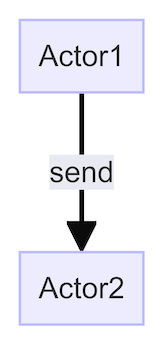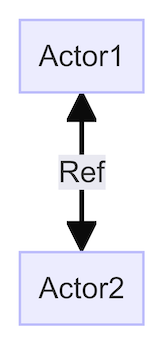Phluxor
Ref / Actor Referece
In a typical actor model toolkit, you cannot directly reference an actor when you create it.
Instead, you get a reference to the actor’s mailbox and communicate with the actor by sending messages to that mailbox.
This reference is called a Phluxor\ActorSystem\Ref,
a.k.a Actor Reference.
This Ref is serializable and can be sent over the network at low cost.
Whether local or remote, you can send messages to actors through Refs.
Phluxor\ActorSystem\Ref to reference an actor.
Overview
in Phluxor, actors communicate with each other by sending messages.
so to send a message, an actor needs a reference to another actor.

When sending a message to an actor, it is important to identify the actor.
In Phluxor, a unique Ref is used to identify actors.
When a new actor is created, a Ref to that actor is returned.
Phluxor automatically assigns a name to the actor that is not assigned to any actor.
When an actor stops, its Ref becomes invalid.

Create Actor
When an actor is spawned, a Ref is created and returned.
root
use Phluxor\ActorSystem;
use Phluxor\ActorSystem\Props;
$system = ActorSystem::create();
// spawn a root actor
// return a Ref
$ref = $system->root()->spawn(
Props::fromProducer(
fn() => new YourActor()
)
);
child
namespace App\ActorSystem;
use App\Command\CreateUser;
use Phluxor\ActorSystem\Context\ContextInterface;
use Phluxor\ActorSystem\Message\ActorInterface;
use Phluxor\ActorSystem\Props;
class YourActor implements ActorInterface
{
public function receive(ContextInterface $context): void
{
if ($msg instanceof CreateUser) {
// spawn a child actor
// return a Ref
$ref = $context->spawn(
Props::fromProducer(
fn() => new YourChildActor()
)
);
}
}
}
Create Manually
Phluxor\ActorSystem\Ref can also be created manually.
Since it is intended to function as an identifier for the actor,
there is no problem with creating and using it manually as long as the name is appropriate.
The Ref is created internally using a Phluxor\ActorSystem\ProtoBuf\Pid object.
There are a few rules to follow when creating it manually,
but for actors that are configured locally, set the address to ActorSystem::LOCAL_ADDRESS.
This address is used to determine whether the actor is local or remote.
If the address is not ActorSystem::LOCAL_ADDRESS, the actor will be considered remote internally.
use Phluxor\ActorSystem;
use Phluxor\ActorSystem\ProtoBuf\Pid;
use Phluxor\ActorSystem\Ref;
new Ref(new Pid([
'id' => 'special-id',
'address' => ActorSystem::LOCAL_ADDRESS,
]));
This Ref Object has a __toString() method,
so you can convert it to a string and output the address.
Send Message
send is a non-blocking, fire-and-forget method for sending a message to an actor.
public function receive(ContextInterface $context): void
{
$msg = $context->message();
switch (true) {
case $msg instanceof StartsClass:
$ref = $context->spawn(
Props::fromProducer(
fn() => new TeacherActor(
$this->students, $context->self()
)
)
);
// send a message to the actor
$context->send($ref, new PrepareTest(['subject' => $msg->getSubject()]));
break;
}
}
Request Message
request is very similar to send,
but it includes the sender’s Ref so that the receiving actor can reply to the sender.
Only use it when request/reply communication is required between two actors.
public function receive(ContextInterface $context): void
{
$msg = $context->message();
switch (true) {
case $msg instanceof StartsClass:
$ref = $context->spawn(
Props::fromProducer(
fn() => new TeacherActor(
$this->students, $context->self()
)
)
);
// request a message to the actor
$context->request($ref, new PrepareTest(['subject' => $msg->getSubject()]));
break;
}
}